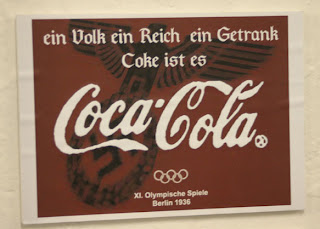After rising through the ranks of various
national and international sporting bodies, not to mention the ruling party in
General Franco’s Spain , and
serving a stint as his country’s ambassador in Moscow U.S.
With Samaranch at the helm, the Olympic
movement became a model of neo-liberalism: television rights were maximised,
the efforts made by bidding city authorities to suck up to the IOC reached
ridiculous proportions (resulting in various bribery scandals), and funds were
diverted away from activities which didn’t earn a profit (eg. the Paralympics,
which receives less funding than the IOC’s stamp collection). The IOC exploits
its coubertiniste heritage to endow
it with moral respectability: it likes to be seen leading the fight against
performance-enhancing drugs or uniting the two Koreas
Juan
Antonio Samaranch: franquista-turned-neoliberal.
By awarding the 2008 Summer Games to Beijing , the IOC completed a dubious hat-trick: it had
awarded its showpiece event to the three most murderous regimes in human
history (after Berlin in 1936 and Moscow
The Olympics don’t need to be held behind
the Iron Curtain or the Great Firewall to be sites of political repression. The
use of force by authorities against those who disrupt their self-congratulatory
carnival has become a feature of every Olympiad, and even in liberal
democracies, the full force of the national security state is thrown behind the
goal of protecting the Olympic brand. Prior to the Vancouver Games in 2010,
Canadian authorities detained journalists who questioned the purpose of the
Olympics. (Australia wasn’t immune to this either – I can still remember former
Democrats’ Senator Andrew Murray’s passionate defence of civil liberties
against the calls of the Howard government for the passage of ‘shoot-to-kill’
laws in the run-up to Sydney 2000.) With the reputations of entire nations on
the line, the logic of neo-liberal capitalism (which, despite its free market
rhetoric, is more accurately termed neo-mercantilism) allows governments to use
the hosting of the Olympics as an excuse for a bit of old-fashioned
authoritarian social control.
The run-up to this year’s London games has
witnessed all the usual hallmarks of Olympism: the displacement of the little
people whose existence gets in the way of the technocrats’ plans for all-seater
state-of-the-art facilities (probably to be torn down after the Games anyway),
the use of anti-terror-style legislation to prevent disruptions by protestors,
and the use of the spectacle by tin-pot demagogues to make some political point
or other (eg. Mahmoud Ahmedinejad, who threatened to boycott London because the
‘2012’ on the Games’ logo looked too much like ‘ZION’). The push for a single UK
When the athletes parade around in the
Opening Ceremony and ‘Er Majesty proclaims ‘let the Games begin’, we would do
well to remember the victims of Olympism: the People’s Olympiad participants
who died in the Spanish Civil War, the Jews and others massacred because of the
political capital granted to Hitler by the staging of the Berlin Games, the
students killed in Mexico City in 1968, and the Georgians killed by Putin’s
goons in 2008.




